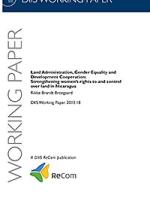Land rights, gender equality and donor cooperation in Nicaragua
Nicaragua has over the past three decades often been praised as a country where the legal framework is progressive with regards to gender-issues in general, and where most legal barriers against women’s rights to own and inherit land have been removed.
However, despite important advances for women’s access to education, to land ownership, to voice and awareness about rights during the 1980s and 1990s, there seems to have been a reversal in this positive development since the mid-00s.
According to the recent OECD Social Institutions and Gender Index (SIGI), Nicaragua has the highest level of gender discrimination in the region of Latin America and the Caribbean.
Contributing to this, there is a markedly skewed distribution between men and women regarding productive resources such as land and animals, and the state as source of land ownership, is much less important for women than for men. There is also a considerable gender-difference regarding access to agricultural extension services and access to credit, as well as regarding education and the labour market.
This paper analyses the role of international donor organisations from their influx since the onset of the civil war from the 1980s.
The revolutionary government of the 1980s rolled out literacy and health programmes, sat out to profoundly change the distribution of land ownership through a redistributive land reform programme, created a new constitution, and was inspired by progressive thoughts about gender equity.
International donor organisations greatly influenced the subsequent Nicaraguan women’s movements and the gender balance. International donors have given support to studies and legal reforms as well as making women’s contribution to society and to the economy as a whole more visible.
Since the electoral victory of the Sandinista party in 2006, the Nicaraguan authorities have increasingly objected to donor support in the area of democratic governance, viewing it as political interference. The withdrawal of funding by six major Western European cooperation agencies has seriously weakened prominent non-Sandinista Civil Society Organisations.
Remaining donors work in an adverse political environment with regards to gender issues. The current government has a ‘familist’ approach, as opposed to ‘feminist’, focusing on traditional patriarchal values, and gender-based violence appears to be on the rise.
In Nicaragua, the legal framework is generally not considered to be the largest barrier to strengthening women’s rights and land rights, with the exception of the lack of legal recognition of common-law marriages. All of the sources and experts consulted highlight that implementation of the legal framework is what is missing. Strengthening of legal literacy is highlighted to be an important part of changing this picture.
The culturally rooted barriers, as well as their ‘institutionalisation’ in the way that institutions such as police and courts work, implies that e.g. activities focusing on titling land that women already own, will have limited effect, if the larger context still discriminates women.
The systematic collection of gender-disaggregated data is an important element in raising awareness among men and women about women’s disadvantaged position as well as its importance for well-being and development. This not only relates to national statistics, but also to evaluations of development interventions.
The paper has been elaborated as part of the recent ReCom review of land rights, gender equality and donor cooperation.

